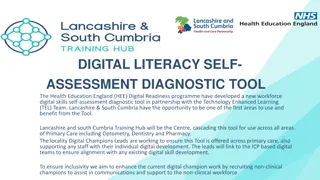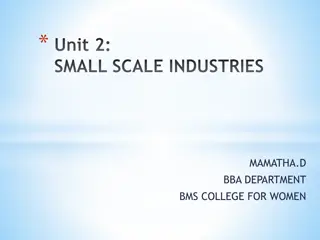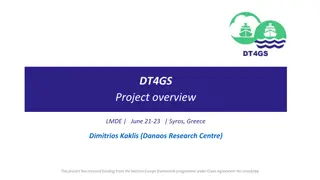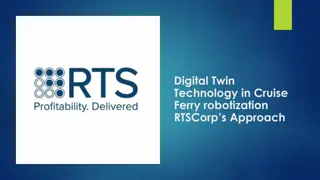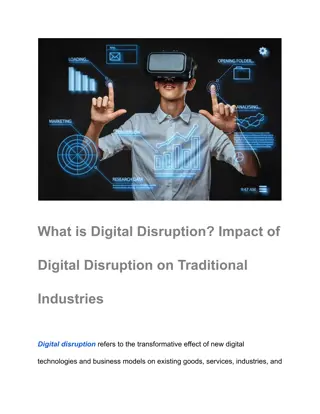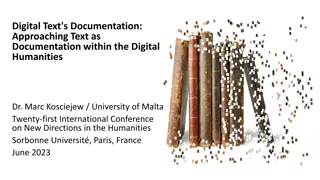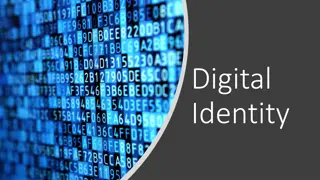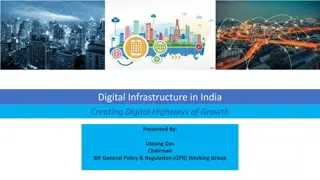Understanding Digital Twin Technology Across Industries
Digital twin technology, a virtual model of physical assets, plays a crucial role in industries by leveraging AI, machine learning, and IoT to enhance performance, predict issues, and improve decision-making. As digital twins become more prevalent, their application extends to various sectors, showcasing their potential for driving innovation and efficiency.
Download Presentation

Please find below an Image/Link to download the presentation.
The content on the website is provided AS IS for your information and personal use only. It may not be sold, licensed, or shared on other websites without obtaining consent from the author. Download presentation by click this link. If you encounter any issues during the download, it is possible that the publisher has removed the file from their server.
E N D
Presentation Transcript
Sample Landscape Study Digital Twin Technology Digital twins can be practically applied in almost every industry. Image Source: Network World
Content Introduction of Digital Twin How it works & Why it matters Economic value of Digital Twin Future of Digital Twin Major Application & Benefits Objectivesof theLandscape/Study Patent Literature Analysis Graphical and AnalyticalRepresentation Appendix 1 Sources Appendix 2 Definition of IPC Sub Classes Patent Searching | Research and Analytics | Patent Prosecution/Preparation Support | Litigation and E-Discovery | IP Valuation | Patent Portfolio Watch
Introduction to Digital Twin Technology What is a digital twin? A digital twin or digital replica is a virtual model of a physical asset such as a product, process, system or a facility. Said digital replica takes and uses data from an actual physical asset to better understand and augment its performance. For example, engineers can identify the safety risks of an aircraft engine by assessing different temperatures and stresses on parts, surgeons can navigate a digital visualization of an organ before operating on it, a digital twin of a rocket that displays its maximum wind resistance can ensure a launch in bad conditions, and so on. Powered by a combination of artificial intelligence (AI), machine learning, and data analytics, digital twins can mirror a physical twin and reveal issues before they occur. To do so, they rely on a range of sensors embedded in the physical world to transfer real-time data about the operative process and environment. The data collected from the connected sensors is then analysed on the cloud and is accessible via a dashboard. Internet of Things an integral part of digital twin technology From the very definition, it s clear that digital twins ought to depend on IoT technologies. Driven by sensors, artificial intelligence, machine learning, data and analytics, IoT acts as the foundation for digital twins, as it leverages specific data about physical assets to help companies make better decisions. Digital twin is, therefore, expected to increase IoT deployments given its ability to add value for end-customers. Experts predict that, within the next five years, digital twins will be adopted by 85% of all IoT platforms. Insight The term DigitalTwin was defined for the first time by Dr. Michael Grives at the University of Michigan 2002/03 in Virtually Perfect Driving Innovative and Lean Products through Product Lifecycle Management. Source: Appendix 1 Patent Searching | Research and Analytics | Patent Prosecution/Preparation Support | Litigation and E-Discovery | IP Valuation | Patent Portfolio Watch
Introduction to Digital Twin Technology Connect & Collect 01 Innovation & Transform 02 Learn & Analyze 05 Digital Twin 04 03 Alert & Advice Decide & Optimize Source: Appendix 1 Patent Searching | Research and Analytics | Patent Prosecution/Preparation Support | Litigation and E-Discovery | IP Valuation | Patent Portfolio Watch
How it works & Why it matters Digital Twin, the virtual counterparts of a physical asset is created as the digitalized duplicate of a machine/ equipment or aa physical site. These digital assets can be created even before an asset is built physically. To create a digital twin of any physical asset, engineers collect and synthesize data from various sources including physical data, manufacturing data, operational data and insights from analytics software. All this information along with AI algorithms is integrated into a physics-based virtual model and by applying Analytics into these models we get relevant insights regarding the physical asset. The consistent flow of data helps in getting the best possible analysis and insights regarding the asset which helps in optimizing the outcome. Digital twins are powerful masterminds to drive innovation and performance. Imagine it as your most talented product technicians with the most advanced monitoring, analytical, and predictive capabilities at their fingertips. By 2018, companies who invest in digital twin technology will see a 30 percent improvement in cycle times of critical processes, predicts IDC. Also, the digital twin technology helps companies improve the customer experience by better understanding customer needs, develop enhancements to existing products, operations, and services, and can even help drive the innovation of new business. Source: Appendix 1 Patent Searching | Research and Analytics | Patent Prosecution/Preparation Support | Litigation and E-Discovery | IP Valuation | Patent Portfolio Watch
Major Applications-Digital Twin Technology Wind Farm Manufacturing Health Care Automobile Aero Space Other Applications Retail, Infrastructure, Oil & Gas Industry and Gas Turbines Source: Appendix 1 Patent Searching | Research and Analytics | Patent Prosecution/Preparation Support | Litigation and E-Discovery | IP Valuation | Patent Portfolio Watch
Economic value of Digital Twin The economic value of the digital twins technology will vary widely, depending on the monetization models that drive them. For complex, expensive industrial or business equipment, services or processes, improving utilization by reducing asset downtime and lowering overall maintenance costs will be extremely valuable, making internal software competencies critical to driving value with digital twins. As such, the costs of developing and maintaining digital twins must be driven by both business and economic models. Digital twins are not developed in a vacuum. Both the business concept and model must be tested against an economic architecture revenue, profits, return on investment (ROI), cost optimization and a way to measure progress as the products/services are rolling out. To obtain the highest value from digital twins, the enterprise must address the digital ethics issues raised by different parties interacting with the data from not just the enterprise, but also its partners and customers. This will require the enterprise to think about the value of the data and its contributions to the business and partners, and also to identify potential areas where its customers or its own data could drive value but also could be at risk. Source: Appendix 1 Patent Searching | Research and Analytics | Patent Prosecution/Preparation Support | Litigation and E-Discovery | IP Valuation | Patent Portfolio Watch
Future of Digital Twin In the future, expect to see the expansion of the IoT, and with it, some version of digital twin technology. According to predictions, by 2022, 85 percent of all IoT platforms will include some kind of digital twinning. As more and more products in our homes and workplaces evolve into smart devices (i.e., they connect to the Internet, providing remote access and control), we ll also see an increase in the availability of digital twin technology. These digital twins already allow you to remotely adjust the temperature in your smart home, for example. Or to make calls using your business number on a softphone that s available on all your personal devices. Source: Appendix 1 Patent Searching | Research and Analytics | Patent Prosecution/Preparation Support | Litigation and E-Discovery | IP Valuation | Patent Portfolio Watch
Benefits of Digital Twin Improve quality & yield Reduce operational costs Increase efficiency of Engineers Digital Twin Optimize robot operation Management Reduce cycle time & boost productivity Diagnose & fix failures Patent Searching | Research and Analytics | Patent Prosecution/Preparation Support | Litigation and E-Discovery | IP Valuation | Patent Portfolio Watch
Objectives of the Study To understand Digital Twins technology and prepare a patent landscape report. To understand major patent holders, geographical distribution of patents, Technologies analysis etc. To analyse patent application filing/publication/grant trends over the years, top assignees, and patent classifications among others. Patent Searching | Research and Analytics | Patent Prosecution/Preparation Support | Litigation and E-Discovery | IP Valuation | Patent Portfolio Watch
Patent Literature Analysis:Assumptions: Report provides patent analysis for the budding technology Viz. Digital Twin that relates to incorporation of digital replicas of physical assets, processes, people, places, systems and devices for various purposes. The landscape study focuses on patents and/or published patents applications pertaining to the technology Digital Twin . The patent search started with identifying relevant search terms and patent classification codes. The IPC codes searched are summarized in the Appendix 2. The study was primarily carried out using Questel-Orbit, a popular database of patent applications and granted patents from 95 patent jurisdictions around the world created by Questel. All analysis in this report has been done on unique families (One publication per family). Broadly, the search query tried to get patent documents pertaining to the Digital Twin . As a result, the analysis obtained 199 relevant patent documents from a total of 2542 patent documents.
Filing BasedTrends Graphical and Analytical Representation 1. Filing Based Trends 80 74 70 60 60 Number of Patents 50 40 30 23 19 20 8 7 10 4 4 0 <2011 2012 2013 2014 2015 2016 2017 2018 Year Insight The filing based trend demonstrates that maximum number of patent applications were filed in the year 2016. # The graph representing filing based trends was prepared based on the earliest priority year. Patent Searching | Research and Analytics | Patent Prosecution/Preparation Support | Litigation and E-Discovery | IP Valuation | Patent Portfolio Watch
2. Geographic Filing Trends Insight Trend related to Geographical filing demonstrates that maximum number of filing were originated in the US followed by CN and EP jurisdictions. # The table representing Geographical filing based trends was prepared based on the analysis of patent family data. Patent Searching | Research and Analytics | Patent Prosecution/Preparation Support | Litigation and E-Discovery | IP Valuation | Patent Portfolio Watch
3. Types of Assignees Practising entities (PEs) Practising entities is someone who makes, uses or sells a product for which patent is granted. Non-practicing entity (NPEs) A non-practicing entity (NPE) is someone who holds a patent for a product or process but has no intentions of developing it. NPEs have been emerging as a prominent feature in the developed countries IP landscape since last many years. NPE s have increasingly become the source of curiosity for manufacturing companies 140 Major PEs, 120 120 100 80 Other PEs, 55 60 40 NPEs, 24 20 0 Major PEs Other PEs NPEs Patent Searching | Research and Analytics | Patent Prosecution/Preparation Support | Litigation and E-Discovery | IP Valuation | Patent Portfolio Watch
3.1. Top Practising Entities (PEs) 60 55 50 40 31 30 20 10 10 4 3 3 3 3 0 Insight General Electric (GE) is the leading patent applicant in Digital Twin Technology, followed by Siemens and Desktop Metal. # The graph representing Top Practising Entities was prepared based on the analysis of patent family data. Patent Searching | Research and Analytics | Patent Prosecution/Preparation Support | Litigation and E-Discovery | IP Valuation | Patent Portfolio Watch
3.2. Non-Practising Entities (NPEs) Ind. Inventor 5 Research Centres/Labs 4 University 15 University Research Centres/Labs Ind. Inventor Patent Searching | Research and Analytics | Patent Prosecution/Preparation Support | Litigation and E-Discovery | IP Valuation | Patent Portfolio Watch
4. Digital Twin Application Analysis 25 Others 23 Entertainment Applications of Digital Twins 30 Wind Farm 31 Industrial IOT 23 Infrastructure 33 Health Care 48 Aerospace 34 Automobile 112 Manufacturing 0 20 40 60 80 100 120 Insight Digital Twin Application Analysis demonstrates that maximum number of Digital Twin patent applications were filed in Manufacturing Industry followed by Aerospace and Automobile Industries. Patent Searching | Research and Analytics | Patent Prosecution/Preparation Support | Litigation and E-Discovery | IP Valuation | Patent Portfolio Watch
5. Assignee Vs Application Trend 80 70 60 50 40 30 20 10 0 Manufacturing Automobile Aerospace Health Care Industrial IOT 1 Wind Farm Entertainment 2 Infrastructure Others Microsoft Tech Immersion 1 1 2 Honeywell Int 2 1 Boeing 2 2 Satellier Screampoint 3 3 Phoenix Contact 3 Desktop Metal 11 Siemens 25 1 1 1 4 1 6 3 GE 30 21 34 18 19 25 3 17 Patent Searching | Research and Analytics | Patent Prosecution/Preparation Support | Litigation and E-Discovery | IP Valuation | Patent Portfolio Watch
5.1 GE Vs Applications Trend 17 Others 25 Wind Farm GE Applications of Digital Twins 19 Industrial IOT 3 Infrastructure 18 Health Care 34 Aerospace 21 Automobile 30 Manufacturing Insight General Electric (GE) Vs Applications Trend demonstrates that GE majorly focussing in Aerospace followed by Manufacturing and Windfarm. Patent Searching | Research and Analytics | Patent Prosecution/Preparation Support | Litigation and E-Discovery | IP Valuation | Patent Portfolio Watch
5.2 Siemens Vs Applications Trend 3 Others 1 Wind Farm Applications of Digital Twins 4 Industrial IOT 6 Infrastructure 1 Health Care 1 Aerospace 1 Automobile 25 Manufacturing Insight Siemens Vs Applications Trend demonstrates that Siemens majorly focussing in Manufacturing followed by and Infrastructure. Patent Searching | Research and Analytics | Patent Prosecution/Preparation Support | Litigation and E-Discovery | IP Valuation | Patent Portfolio Watch
6. Technical Dissection Other 24% Test/Monitor/Control 42% Data Processing, 34% Insight Maximum number of patents/applications are falling under Test/Monitor/Control (42%) followed by Data Processing (34%). Patent Searching | Research and Analytics | Patent Prosecution/Preparation Support | Litigation and E-Discovery | IP Valuation | Patent Portfolio Watch
Technical Dissection (Extended) Data Processing Test/Monitor/Control Training 4% Autonomous System 5% Other 5% Detection/Measurement 40% Process/Performance 48% Simulation 19% Object (Behaviour or Health) 42% Analysis/Computing 37% Others Synthesizing Data 48% Miscellaneous 35% 3D Models 17% Patent Searching | Research and Analytics | Patent Prosecution/Preparation Support | Litigation and E-Discovery | IP Valuation | Patent Portfolio Watch
7. IPCs BasedTrends IPC DEFINITION G06F Electric Digital Data Processing G06F 25% G05B Control or Regulating Systems in General; Functional Elements of Such Systems; Testing Arrangements for Such Systems or Elements Monitoring or Others 43% H04L Transmission of Digital Information, e.g. Telegraphic Communication G06Q Data Processing Systems or Methods, Specially Adapted for Administrative, Commercial, Financial, Managerial, Supervisory or Forecasting Purposes; Systems or Methods Specially Adapted for Administrative, Commercial, Financial, Managerial, Supervisory or Forecasting Purposes, Not Otherwise Provided For [2006.01] G05B 14% H04L 10% G06Q 8% Insight Majority of patent applications were assigned with IPC G06F and G05B followed by IPC H04L and G06Q Source:WIPO Patent Searching | Research and Analytics | Patent Prosecution/Preparation Support | Litigation and E-Discovery | IP Valuation | Patent Portfolio Watch
IPC Sub ClassDistribution G05B, SUB SECTIONS G06F, SUB SECTIONS G05B- 019/418 34% G06F-017/50 29% Others 33% Others 41% G06F-003/01 12% G05B- 019/4099 11% G05B- 023/02 11% G05B- 017/02 11% G06F-019/00 8% G06F-017/30 10% H04L, SUB SECTIONS G06Q, SUB SECTIONS G06Q- 050/04 6% H04L-029/06 22% G06Q- 050/00 6% Others 28% G06Q- 030/02 12% G06Q- 010/06 47% H04L- H04L-029/08 22% 012/841 11% G06Q- 010/00 29% H04L-012/24 17% Patent Searching | Research and Analytics | Patent Prosecution/Preparation Support | Litigation and E-Discovery | IP Valuation | Patent Portfolio Watch
APPENDIX 1:Sources [1] https://www.netscribes.com/digital-twin-next-frontier-iot/ [2] https://www.happiestminds.com/insights/digital-twins/ [3] https://www.i-scoop.eu/internet-of-things-guide/industrial-internet-things-iiot-saving-costs-innovation/digital- twins/ [4] Templates [5] Icons made by Freepik, Geotatah from flaticons [6] https://www.gartner.com/smarterwithgartner/prepare-for-the-impact-of-digital-twins/ [7] Dr. Michael Grieves, Digital Twin: Manufacturing Excellence through Virtual Factory Replication , 2014 [8] https://jive.com/resources/blog/what-is-digital-twin-technology/ [9] https://www.forbes.com/sites/bernardmarr/2017/03/06/what-is-digital-twin-technology-and-why-is-it-so- important/#266561122e2a Patent Searching | Research and Analytics | Patent Prosecution/Preparation Support | Litigation and E-Discovery | IP Valuation | Patent Portfolio Watch
APPENDIX 2: IPC Sub-classDefinitions IPC SUB-CLASS DEFINITIONS Total factory control, i.e. centrally controlling a plurality of machines, e.g. direct or distributed numerical control (DNC), flexible manufacturing systems (FMS), integrated manufacturing systems (IMS), computer integrated manufacturing (CIM) G05B-019/418 G05B-019/4099 Surface or curve machining, making 3D objects, e.g. desktop manufacturing G05B-023/02 Electric testing or monitoring Electric G05B-017/02 Input arrangements or combined input and output arrangements for interaction between user and computer G06F-003/01 G06F-017/50 Digital computers in general Source:WIPO Patent Searching | Research and Analytics | Patent Prosecution/Preparation Support | Litigation and E-Discovery | IP Valuation | Patent Portfolio Watch
APPENDIX 2: IPC Sub-classDefinitions IPC SUB-CLASS DEFINITIONS G06F-017/30 Information retrieval; Database structures therefor Digital computing or data processing equipment or methods, specially adapted for specific applications G06F-019/00 G06Q-010/00 Administration; Management Resources, workflows, human or project management, e.g. organising, planning, scheduling or allocating time, human or machine resources; Enterprise planning; Organisational models G06Q-010/06 Marketing, e.g. market research and analysis, surveying, promotions, advertising, buyer profiling, customer management or rewards; Price estimation or determination G06Q-030/02 Source:WIPO Patent Searching | Research and Analytics | Patent Prosecution/Preparation Support | Litigation and E-Discovery | IP Valuation | Patent Portfolio Watch
APPENDIX 2: IPC Sub-classDefinitions IPC SUB-CLASS DEFINITIONS Systems or methods specially adapted for specific business sectors, e.g. utilities or tourism G06Q-050/00 G06Q-050/04 Manufacturing H04L-012/24 Arrangements for maintenance or administration H04L-012/841 Flow control actions using time consideration, e.g. round trip time H04L-029/06 Characterised by a protocol H04L-029/08 Transmission control procedure, e.g. data link level control procedure Source:WIPO Patent Searching | Research and Analytics | Patent Prosecution/Preparation Support | Litigation and E-Discovery | IP Valuation | Patent Portfolio Watch
Disclaimer IIPRD has prepared this sample report as an exemplary report, wherein the content of the report is based on internal evaluation of Patents and Non-Patent Literature that is conducted based on Databases and Information sources that are believed to be reliable by IIPRD. A complete list of patent documents retrieved is not disclosed herein as the report is exemplary but can be shared if desired based on terms and conditions of IIPRD. IIPRD disclaims all warranties as to the accuracy, completeness or adequacy of such information. The above sample report is prepared based on the search conducted on the keywords and other information extracted from the understanding of the Patent Analysts of IIPRD, and subjectivity of the researcher and analyst. Neither IIPRD nor its affiliates nor any of its proprietors, employees (together, "personnel") are intending to provide legal advice in this matter. Patent Searching | Research and Analytics | Patent Prosecution/Preparation Support | Litigation and E-Discovery | IP Valuation | Patent Portfolio Watch
AboutIIPRD IIPRD is a premier Intellectual Property Consulting and Commercialization/Licensing Firm with a diversified business practice providing services in the domain of Commercialization, Valuation, Licensing, Transfer of Technology and Due- Diligence of Intellectual Property Assets along with providing complete IP and Patent Analytics and Litigation Support Services to International Corporate and Global IP Law Firms. Patent Searching | Research and Analytics | Patent Prosecution/Preparation Support | Litigation and E-Discovery | IP Valuation | Patent Portfolio Watch
ContactDetails ContactDetails Noida (NCR) Office Head Office E-13, UPSIDC Site-IV, Behind Grand Venice, Greater Noida, 201308 Contact Person: Tarun Khurana Contact No(s):+91-(120) 4296878, 4909201, 4516201 E-Mail: iiprd@iiprd.com, info@khuranaandkhurana.com Website: www.iiprd.com| www.khuranaandkhurana.com Delhi | Noida | Mumbai | Pune | Bangalore | Hyderabad | Indore US | Bangladesh | Myanmar | Vietnam | Nepal | Malaysia | Sri Lanka Patent Searching | Research and Analytics | Patent Prosecution/Preparation Support | Litigation and E-Discovery | IP Valuation | Patent Portfolio Watch






